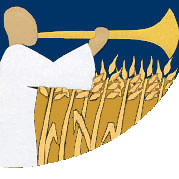 |

|

|
The Book of Mormon and the angel Moroni are two of the most basic symbols
of Latter-day Saint religion. Whether or not it is literally true, the story of the angel's visit and of the
miraculous translation of the golden plates expresses concepts fundamental to LDS faith. To the first Latter-day Saints, this story
was a declaration that God calls and inspires people in the
modern age as in biblical times (D&C 20:5-12).
The book was a tangible sign that
God was working to bring about the fulfillment of the millennial promises
(3 Ne. 21:2, 7). Moroni's appearance
was the first in a series of angelic visions that showed heaven in communication
with earth, offering good news, consolation, and hope for the future
(D&C 128:19-22).
To people who had been taught to view the Bible alone as God's word,
the Book of Mormon proclaimed that God "manifest[s] himself unto
all nations" (Title Page) and that revelation
is ongoing. The Book of Mormon describes itself as an instrument in confounding
false teachings, overcoming contention, and establishing peace (2
Ne. 3:12). Among the false teachings that the book condemns are
gender and racial discrimination (2 Ne. 26:33)
and indifference to the poor, especially by churches (Morm.
8:35-39). When we use the Book of Mormon as "evidence"
for LDS claims to authority, we run the risk of contributing to religious
contention instead of overcoming contention. How to use the book to cultivate
interfaith unity and to promote peace are challenges requiring creative
spiritual discernment.
| An Angel from on High (Hymns
13) |
| What Glorious Scenes
Mine Eyes Behold (Hymns 16) |
B. H. Roberts: From this
new volume of scripture we learn that the mercies and favors of God
are not confined to the inhabitants of the eastern hemisphere; but
he of whom it is said that he is "no respecter of persons,"
had regard for the races of men who inhabited the western half of
the world.
|
| Defense of the Faith
and the Saints (Salt Lake City: Deseret News, 1907), 1:12 |
Hugh B. Brown: The
vital and dynamic message of Mormonism is that there is a personal
God in the heavens. . . . He has not abated his power; he has not
surrendered his sovereignty; he has not diluted his love; he changes
not; and his plans never fail. . . . The character, personality,
and purposes of God have been again revealed to the world. The kingdom
of God has been set up as predicted by Daniel and other prophets.
An angel has flown in the midst of heaven in the latter days in
confirmation of John's vision recorded in the fourteenth chapter
of Revelation, where he said: "And I saw another angel fly
in the midst of heaven, having the everlasting gospel to preach
unto them that dwell on the earth, and to every nation, and kindred,
and tongue, and people, saying with a loud voice, Fear God, and
give glory to him; for the hour of his judgment is come: and worship
him that made heaven, and earth, and the sea, and the fountains
of waters."
|
| Conference Report,
October 1962, 43 |
Bruce R. McConkie:
One of the great evidences of the Lord's goodness, mercy, and condescension
toward his children on earth is found in the coming forth of the
Book of Mormon.
|
| Mormon Doctrine, 2nd
ed. (Salt Lake City: Bookcraft, 1966), 719 |
Bruce R. McConkie:
In a great chorus of worship and desire, the prayers of the saints
ascend to the Great God: "Thy kingdom come. The will be done
in earth, as it is in heaven," they say. . . . The great issue
was not what the Lord designed to do in the latter days,
but when it should come to pass. What was the sign and
when should it be given? . . . The promised sign is the Book of
Mormon. When that volume of holy scripture comes forth, then all
men may know that the Lord has already commenced his work. . . .
We cannot state it too plainly; we cannot affirm it too positively;
we cannot proclaim it with too great a fervor—the Book of
Mormon is the sign given of God to herald the fulfillment of the
covenants made of old.
|
| The Mortal Messiah
(Salt Lake City: Deseret Book, 1979-1981), 4:347, 351-52 |
Ezra Taft Benson:
God uses the power of the word of the Book of Mormon as an instrument
to change people's lives.
|
| A Witness and a Warning
(Salt Lake City: Deseret Book, 1988), 32 |
|

|
 |
